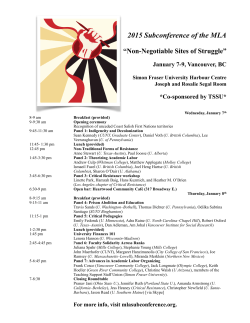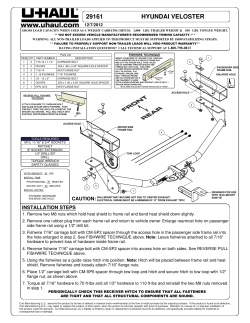
Document
Assembly instructions SF 50 / SF 50c SF 55 / SF 55c SF 75 / SF 75c / SF 75H A B B C D Scope of delivery: A. Top rail B. Vertical profile C. Floor rail D. Hinged panel, sliding panel Accessories pack Safety instructions: These assembly instructions are specifically designed for the use of authorised specialists. Observation and implementation of the relevant safety regulations are a prerequisite. Symbols used: Tools required: Caution Note Content Description Page 1. Assembly of door frame 2. Mounting of door frame 3. Fitting of panel 4. Adjustment 5. External foam sealing 6. Fitting of accessories 3 4 5, 6 6 7 7 SF 55 sliding post with impair number of panels SF 55 sliding post with pair number of panels 8 9 SF 55 assembly of the panel notch 10 SF 75H assembly 11, 13 Handling Maintenance and servicing instructions 15 16, 17 Importent: After successful assembly the fitter must give instructions to the customer in order to avoid incorrect operation. © Copyright | SUNFLEX Aluminiumsysteme GmbH | Im Ruttenberge 12 | D-57482 Wenden | Issue: 11/2013 2 1. Assembly of the window frame 1 oben top Top rail Carriage bracket Links Left unten bottom Assembly shoe Before assembling please ensure the guide shoes are inserted. Vertical frame (locking post) oben top Vertical frame (band side) Assembly shoe Adjustment opening Assembly shoe oben top Rechts Right unten bottom Assembly shoe unten bottom Floor/Guide profile • Unpacking the supplied frame profile. • Sorting of the frame profile - The floor rail has external water drain slots on the internal opening element. - Top rail has no water drain slots. - The vertical profiles are marked “right” and “left” (viewed from the inside) on the wall side. • The vertical profiles must be pushed flush into the guide rail. • Cutout (Adjustment opening) is directed only at the bottom rail. 3 2. Installation of the window frame 2 • Place the frame in the building opening. • Arrange window frame vertically. Check for parallel fitting! • Determination of fixing points (pic 2a). - Approx 100-200 mm from external frame cover, distribute remainder at an interval of approx 300 – 400 mm. - The vertical assembly points are distributed evenly along the height. • Support floor rail every 300 mm. • Rectangle the alignment and wedging of the frame. • Screw tight all profiles except for the locking posts. 2a 4 3. Fitting the panel 3 Top rail Carriage bracket Assembly shoe Assembly shoe Panel 1 Panel 2 Vertical frame (locking post) Assembly position ectio n Carriage fitting Fixin g dir Assembly position Fixin g dir n ectio ectio n g dir Fixin Vertical frame (band side) Bearing bolt Panel 3, 4, ... Bearing bolt Carriage fitting Assembly shoe Assembly shoe Floor/guide profile • Fit the first panel and secure with the hinge bolts provided (the panel are numbered at the top and bottom. 4 Position of handle: If the locking bar on the panel profile is firmly pushed in flush the handle always points upwards. 5 • Place the second panel with the bearing bolts in the carriage (C) and fit to the first panel. • The upper bearing bolt must be pressed fully down. CC 2 1 1 = Lock using M5 grub screw Allen key 2.5 mm 2 = Height adjustment using M10 grub screw Allen key 5 mm Clearance panel to floor rail approx. 8 mm 5 6 1 • Now screw the upper bearing bolt into the guide carriage (D) until the bolt is flush with the bracket. • Close the first pair of panels and repeat the first four steps of point 3 according to the number of panels and panel arrangement. CD 2 1 = Lock using M5 grub screw Allen key 2.5 mm 2 = Height adjustment using M10 grub screw Allen key 5 mm 7 A B • All hinge bolts should now be secured with the supplied grub screws (B). The corresponding holes are in the integral hinge section. They are clearly visible when an element is open. 4. Adjustment 8 de d si Ban t pos ing Lock • The closure clearance is set by sliding the window frame locking post. When the locking post shows a constant (approx 8 mm wide) closure clearance with the panel, this can then be wedged and screwed in. • For panel distribution left and right the closure is set by re-wedging of the band side vertical post. • The adjustment bearing bolts permit the panel height within the picture frame to be adjusted. This can be easily adjusted in the mounted state with unlocked panels. 6 5. Foam sealant 9 The window frame corners must be fully sealed from the inside. 6. Accessory installation 10 11 • Diagram shows view from above of the SF clip. Turn panel • Fit the supplied panel clips to the panel as shown in the illustration. • To release, move panel packet from parking position. The trigger lock released when closing automatically. The illustration shows the stop strip (swivel panel). Only by uneven number of panels (3, 5, 7 ...) 7 SF 55 (sliding post with impair number of panels) 1 Top rail Assembly shoe Assembly shoe Panel 1 Panel 2 Panel3, 5, ... Carriage fitting Carriage fitting Assembly shoe Assembly shoe Floor/guide profile Sliding post 3 2 A Vertical frame (locking post) ectio n Fixin g dir Assembly position Assembly position Fixin g dir n ectio ectio n Support for the guide carriage g dir Fixin Vertical frame (band side) Support for the guide carriage 4 A • Picture 2: B 5 B Bolt (A) carriage bracket Bolt (B) carriage • Insert the sliding post in a slightly angled position first into the carriages (bottom rail, picture 3) and only afterwards into the carriage brackets (top rail). • Picture 4 shows sliding post positioned in bottom rail. • Picture 5 shows sliding post positioned in top rail. 8 SF 55 (sliding post with pair number of panels) 1 Sliding post connection bolt Assembly shoe Assembly shoe Panel 1 Vertical frame (locking post) Sliding post n ectio Fixin g dir ectio n g dir Fixin Assembly position Support for the guide carriage Panel 2, 4, ... Carriage fitting Assembly shoe Assembly shoe Sliding post connection bolt 2 4 3 A • Picture 2: B 5 Bolt (A) carriage bracket Bolt (B) carriage • Insert the sliding post in a slightly angled position first into the carriages (bottom rail, picture 3) and only afterwards into the carriage brackets (top rail). • Picture 4 shows sliding post positioned in bottom rail. • Picture 5 shows sliding post positioned in top rail. 9 SF 55 (Assembly of the panel notch) 1 Position 559939-2 2 3 559939-2 4 Only by uneven number of panels (3, 5, 7 ...) 10 SF 75H (Assembly) 1 2 3 4 5 11 6 7 8 9 10 11 12 12 13 14 13 14 Handling Opening of the first panel Folding of the connected elements Parking of the folded panels 15 Maintenance and servicing instructions General External building parts are not only subject to the weather, but also increased stress caused by smoke, industrial fumes and aggressive airborne dust. In conjunction with rain and dew, deposits of these substances may affect the surface and change the appearance. External parts must therefore be cleaned (at least twice annually or more frequently depending on the degree of contamination) to avoid possible settling of deposits. The sooner you remove dirt from the surface, the easier it is to clean. Observe the safety instructions and instructions for use of the respective servicing and cleaning products. When cleaning do not use a material with an unknown composition. If you are not certain about the effect of the cleaner , then test it first by cleaning a visually unimportant, non-exposed portion of the component. Fittings All fittings must be regularly checked for tightness and wear. Attachment screws must be tightened and defective parts replaced as required. In addition, at least once a year, all moving and sliding fittings must be lightly greased with fitting grease. Only servicing and cleaning agents that do not affect the corrosion protection of fittings should be used. Glass surfaces Dirty glass surfaces can be cleaned using water and a sponge or cloth, etc. Commercially available non-abrasive glass cleaners (such as Ajax, Pril, etc.) can be added to the water. Stubborn stains such as paint or tar splashes should be removed with methylated spirits or white spirit. Caution! Do not use alkaline caustic solutions, acids, and fluoride-containing detergents to clean glass surfaces. Caution! A suitable protective film should be used to protect the glass surface against mortar spattering, cement slurry, sparks or weld sputtering from partitioning screens and stone-facade acidic-cleaner.. Seals All seals must be cleaned and lubricated at least once a year to ensure good functioning. For this purpose we recommend the use of a seal care product. The care product maintains the suppleness of the seal, thus preventing premature brittleness. Ensure that the seals are not damaged and do not come into contact with solvent materials. Aluminium surfaces Anodizing and powder coating is a highly durable and decorative finishing for aluminium components. To maintain the decorative appearance of such components for decades, the surfaces need to be regularly maintained by means of cleaning twice a year. Cleaning anodized surfaces Cleaning of the surfaces must not take place in direct sunlight, the surface temperature must not exceed 25°C. Use only neutral pH cleaners such as normally diluted washing up liquid. Abrasive or scouring materials must not be used to clean heavily soiled, anodized surfaces - cleaning pastes are available. 16 Cleaning powder-coated surfaces In the same way as for anodized elements, cleaning must be carried out whilst cold (maximum of 25 °C surface temperature). In this case also, use only pH-neutral material. Solvent-based cleaners attack the surface of the powder coating and, like scouring or abrasive cleaners, should not be used. To remove stubborn fat and greasy dirt we recommend aroma-free methylated spirits. This must only be applied for a short time and then rinsed off with clean water. In addition, we recommend treatment with car wax to leave a water-repellent film. Check on a non-exposed area whether the material used has an adverse effect on the shine. Wood surfaces on wood/aluminium elements For the cleaning of internal wood surfaces it is best to use mild detergent such as dilute detergent and soap suds. Since the internal wood surfaces are not subject to wear and weathering by rain and sun light, painting is not required. Avoid abrasive, corrosive and solvent-based cleaners. Use only soft cloths to avoid scratching the paint surface. Window cleaners contain small traces of alcohol and ammonium chloride. These materials are very suitable for cleaning the glass as well as the wood-frame sections. After cleaning, dry the wood profiles with a dry, soft cloth, because extended exposure to alcohol can soften the paint surface. SUNFLEX Aluminiumsysteme GmbH Im Ruttenberge 12 D-57482 Wenden-Gerlingen Tel.: +49 (0) 2762 / 9253-0 Fax: +49 (0) 2762 / 9253-280 info@sunflex.de 17 18 19 SUNFLEX Aluminiumsysteme GmbH | Im Ruttenberge 12 | 57482 Wenden-Gerlingen | Tel.:+49 (0)2762 9253-0 | Fax:+49 (0)2762 9253-280 | www.sunflex.de | info@sunflex.de
© Copyright 2025








